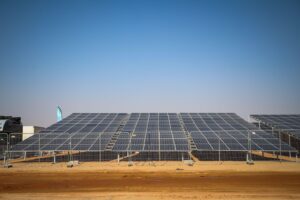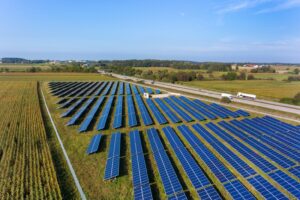Global power-sector emissions hit an “all-time high” in 2024, despite solar and wind power continuing to grow at record speed, according to analysis from thinktank Ember.
Emissions from the sector increased by 1.6% year-on-year, to reach a record high of 14.6bn tonnes of carbon dioxide (tCO2).
This increase was predominantly due to a 4% growth in electricity demand worldwide, leading coal generation to increase by 1.4% and gas by 1.6%.
Embers’ analysis finds that the increase in fossil-fuel generation was, in particular, due to hotter temperatures in 2024, which drove up electricity demand in key regions such as India.
Clean electricity generation grew by a record 927 terawatt house (TWh), which would have been sufficient to cover 96% of electricity demand growth not caused by higher temperatures.
Despite the increase in emissions in the short-term, this “should not be mistaken for failure of the energy transition”, notes Ember, but a sign we’re nearing a “tipping point” wherein changes in weather and demand hold a particularly strong sway.
Clean-power growth
Low-carbon energy sources – renewables and nuclear – provided 40.9% of the world’s electricity in 2024, according to Ember.
This is the first time they have passed the 40% mark since the 1940s, when hydropower contributed around that percentage and coal made up 55%.
Renewable power sources collectively added a record 858TWh of generation last year – a 49% increase on the previous record set in 2022 of 577TWh.
Solar dominated electricity generation growth for the third year in a row in 2024, adding 474TWh of generation, as shown on the chart below. This was up 29% on 2023.
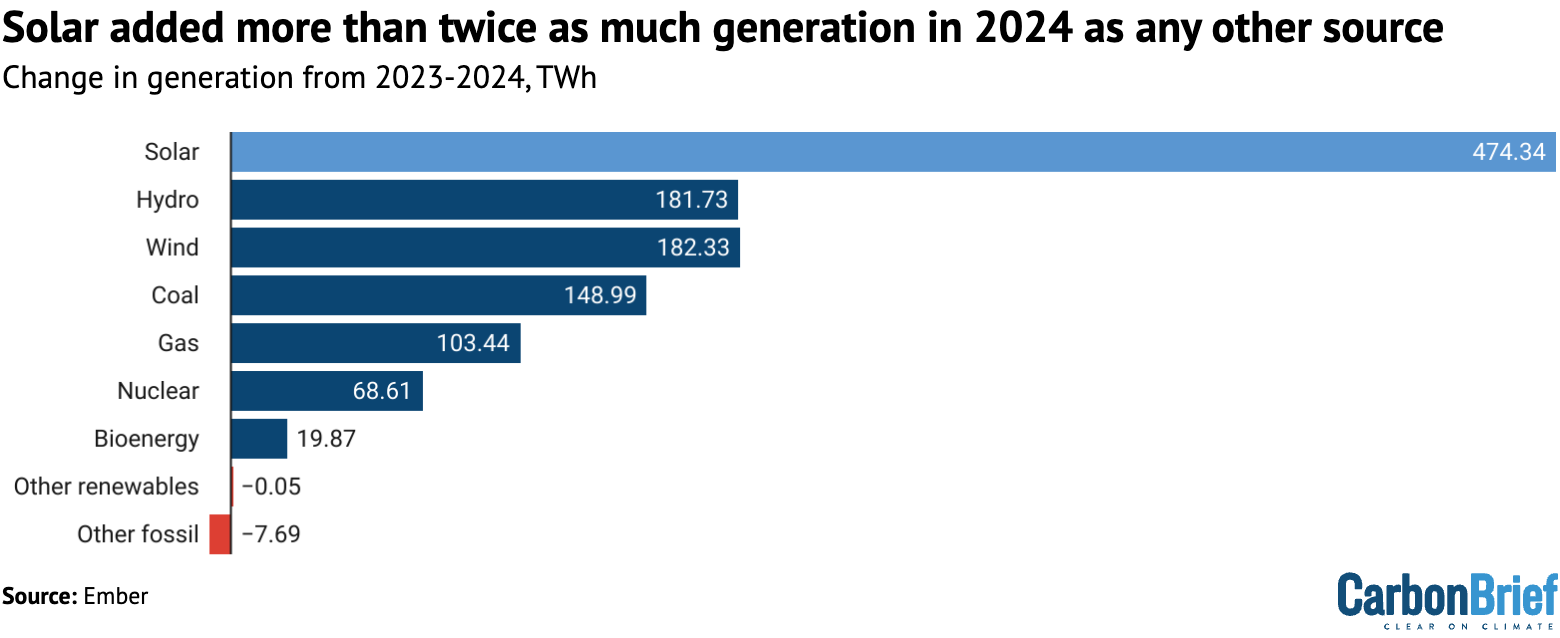
This allowed solar, which hit a total global capacity of 2,131TWh, to meet 40% of global electricity demand growth in 2024 alone.
Solar generation “avoided” an estimated 1,658MtCO2 in 2024 – equivalent to the power-sector emissions of the US, according to Ember.
The technology’s significant growth in 2024 – with more solar capacity installed last year than annual capacity installations of all fuels combined in any year before 2023 – continues a trend seen over recent years.
Across 99 countries, the electricity they produce from solar power has doubled in the past five years.
In 2024, non-OECD economies accounted for 58% of global solar generation, with China accounting for 39% alone. A decade ago the 38 Organisation for Economic Co-operation and Development (OECD) countries – a group founded in 1961 to stimulate economic growth and global trade – made up 81% of global solar generation.
This shift follows the cost of solar falling more than 90% between 2010 and 2023, according to the International Renewable Energy Agency (IRENA). The low cost of the technology has been a key factor in deployment rising sharply worldwide.
It has also enabled new markets to emerge, with Saudi Arabia and Pakistan among the top importers of Chinese solar panels in 2024, according to a recent guest post on Carbon Brief.
In a statement, Phil MacDonald, Ember’s managing director said:
“Solar power has become the engine of the global energy transition. Paired with battery storage, solar is set to be an unstoppable force. As the fastest-growing and largest source of new electricity, it is critical in meeting the world’s ever-increasing demand for electricity.”
Wind generation also grew in 2024, although at a more moderate pace than solar power. Globally, an additional 182TW of wind capacity was added, or an increase of 7.9%.
Despite continued capacity additions, some geographies saw their lowest increase in wind generation in four years due to reduced wind speeds, notes Ember.
Hydro generation rebounded as drought conditions eased in 2023. This was particularly true in China, where capacity increased 130TWh, it adds.
Coal generation grew to 10,602TWh and gas generation to 6,788TWh, an increase of 149TWh and 104TWh, respectively.
However, due to the increases in renewable generation – despite coal and gas generation increasing in absolute terms – their share of generation has fallen.
Coal generation has dropped from 40.8% in 2007 to 34.4% in 2024, according to Ember. The share of gas generation has fallen for four consecutive years now since its peak in 2020 at 23.9%, with 22% of the world’s electricity generation from gas in 2024.
The increase in fossil-fuel generation was virtually identical in 2024 as it was in 2023, despite electricity demand growing (245TWh vs 246TWh, respectively).
Increased demand in short-term
Emissions in the power sector grew by 223mtCO2, despite the increase in renewables due to fossil fuels being relied on to meet increased demand, according to Ember.
Electricity demand increased by 4% over 2024 to meet 30,856TWh globally – crossing the 30,000TWh point for the first time ever. This is up from a 2.6% increase seen in 2023.
Fossil-fuel generation rose to meet the additional demand increase of 208TWh that was specifically driven by higher temperatures, according to Ember.
This dynamic was particularly pronounced in countries that experienced strong heatwaves.
For example, heatwaves in India led to the country experiencing its hottest day on record, with the western Rajasthan state’s Churu city hitting 50.5C on 28 May.
Coal-generation growth met 64% of India’s electricity demand growth in 2024, according to Ember, including that created by air conditioning.
However, this is still less than 91% of electricity demand growth in 2023, highlighting India’s continued transition away from coal, despite short-term trends.
On a global basis, if 2024 had the same temperatures as 2023, fossil generation would have increased by just 0.2%, Ember notes.
As it was, renewables met three-quarters of demand increases, with coal and gas meeting the majority of the rest.
Alongside heatwaves, emerging sectors such as data centres and electric vehicles (EVs), had a modest impact on increased electricity demand.
Demand from data centres and cryptocurrency mining increased by 20% in 2024, adding 0.4% to global electricity demand.
EV electricity demand increased by 38% in 2024, adding 0.2% to global electricity demand.
Despite increasing electricity demand, the growth of fossil fuels is still expected to be nearing the end.
According to Ember, assuming typical capacity factors, solar generation is expected to grow at an average rate of 21% per year between 2024 and 2030. Similarly, wind is expected to grow 13% per year.
Together with modest hydro and nuclear power growth, clean generation is expected to increase by an average of 9% per year to the end of the decade, adding 8,399TWh of annual generation by 2030.
This increase would be sufficient to keep pace with an increase in demand of 4.1% per year to 2030, exceeding the International Energy Agency’s (IEA) “stated policies scenario” scenario forecast of 3.3%, as shown in the chart below.
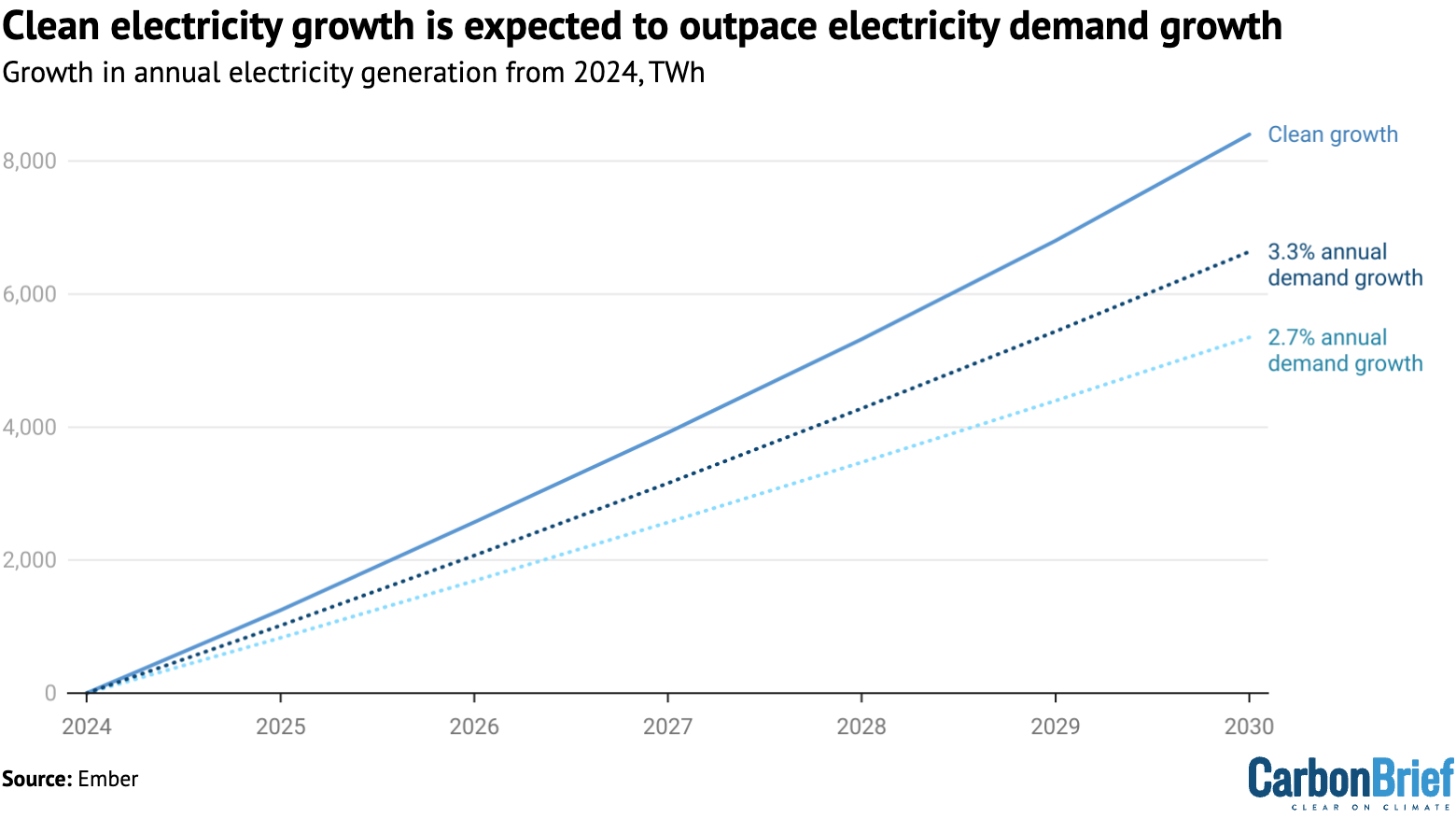
As such, over the next few years, while “changes in fossil generation in the short-term may be noisy, the direction and ultimate destination are unmistakable”, notes the Ember report, adding: “The global energy transition is no longer a question of if, but how fast.”
Many of the changes are expected to be partially determined by weather condition fluctuations from year to year.
Temperature effects impacted generation as well as demand. For example, if global weather conditions in 2024 had been in line with the five-year average, wind generation would have been 2TWh higher and hydro would have been 86TWh higher.
China and India
The world’s largest emerging economies are “on a path of clean electricity expansion that is set to reverse their power-sector fossil growth trends, tipping the global balance on fossil generation”, according to Ember.
China’s clean electricity additions met 81% of demand growth in 2024, due to record wind and solar capacity installations. This is the highest share since 2015 when the country saw its demand fall.
Its 623TWh increase in electricity demand was largely met by wind and solar, which collectively added 356TWh and a rebound in hydro generation which added 130TWh.
Fossil-fuel generation increased by 116TWh in 2024, a third of that seen in 2023, as shown in the chart below.
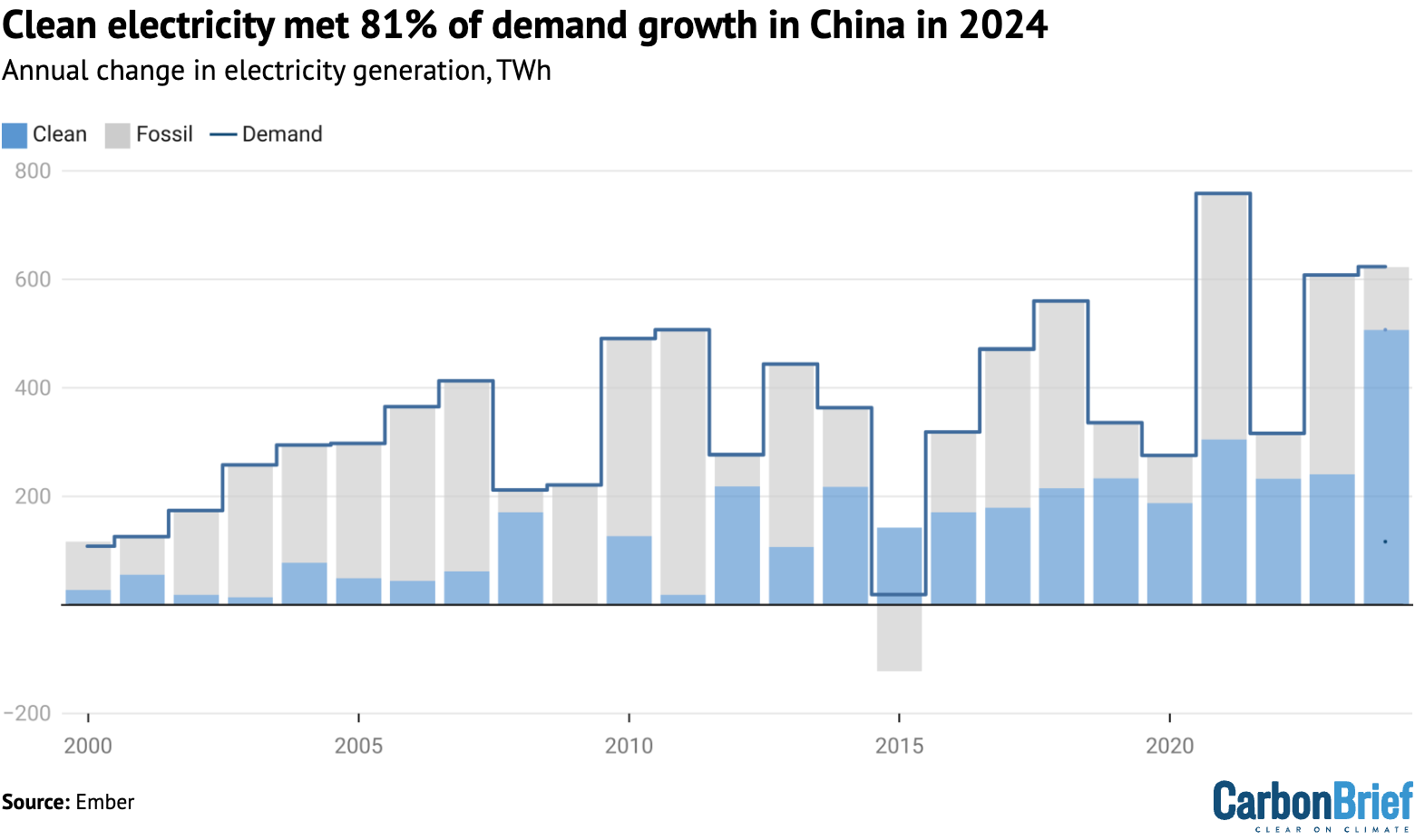
According to Ember, without the impact of hotter weather, clean generation would have met 97% of China’s rise in electricity demand in 2024.
The country’s renewables surge kept CO2 emissions below those for 2023 over the last 10 months of 2024, according to analysis for Carbon Brief.
Ember’s report suggests that India is likely to surpass China to become the country with the largest fossil-fuel generation growth in the coming years. Its fossil-fuel generation increase was the second-largest of any country in 2024 at 67TWh.
However, the cost of solar has fallen by 90% globally between 2010 and 2023. This has led to capacity increasing by 24 gigawatts of alternating current (GWac) in 2024 in India.
Currently, there are 143 gigawatts (GW) of wind and solar capacity under construction in the country, made up of 82GW of solar, 25GW of wind and 36GW of hybrid capacity.
Utility-scale projects already under construction as of January 2025 will nearly double India’s wind and solar capacity, notes Ember.
Elsewhere, wind and solar together generated 17% of the US’s electricity in 2024. The share of coal in the electricity mix fell below 15% – an all-time low – but gas generation rose, with the US accounting for more than half of the global gas generation increase in 2024.
Solar overtook coal generation in the EU for the first time in 2024 with the block seeing the largest fall in coal generation globally.
The post Power-sector CO2 hits ‘all-time high’ in 2024 despite record growth for clean energy appeared first on Carbon Brief.
Power-sector CO2 hits ‘all-time high’ in 2024 despite record growth for clean energy
Climate Change
DeBriefed 15 August 2025: Raging wildfires; Xi’s priorities; Factchecking the Trump climate report
Welcome to Carbon Brief’s DeBriefed.
An essential guide to the week’s key developments relating to climate change.
This week
Blazing heat hits Europe
FANNING THE FLAMES: Wildfires “fanned by a heatwave and strong winds” caused havoc across southern Europe, Reuters reported. It added: “Fire has affected nearly 440,000 hectares (1,700 square miles) in the eurozone so far in 2025, double the average for the same period of the year since 2006.” Extreme heat is “breaking temperature records across Europe”, the Guardian said, with several countries reporting readings of around 40C.
HUMAN TOLL: At least three people have died in the wildfires erupting across Spain, Turkey and Albania, France24 said, adding that the fires have “displaced thousands in Greece and Albania”. Le Monde reported that a child in Italy “died of heatstroke”, while thousands were evacuated from Spain and firefighters “battled three large wildfires” in Portugal.
UK WILDFIRE RISK: The UK saw temperatures as high as 33.4C this week as England “entered its fourth heatwave”, BBC News said. The high heat is causing “nationally significant” water shortfalls, it added, “hitting farms, damaging wildlife and increasing wildfires”. The Daily Mirror noted that these conditions “could last until mid-autumn”. Scientists warn the UK faces possible “firewaves” due to climate change, BBC News also reported.
Around the world
- GRID PRESSURES: Iraq suffered a “near nationwide blackout” as elevated power demand – due to extreme temperatures of around 50C – triggered a transmission line failure, Bloomberg reported.
- ‘DIRE’ DOWN UNDER: The Australian government is keeping a climate risk assessment that contains “dire” implications for the continent “under wraps”, the Australian Financial Review said.
- EXTREME RAINFALL: Mexico City is “seeing one of its heaviest rainy seasons in years”, the Washington Post said. Downpours in the Japanese island of Kyushu “caused flooding and mudslides”, according to Politico. In Kashmir, flash floods killed 56 and left “scores missing”, the Associated Press said.
- SOUTH-SOUTH COOPERATION: China and Brazil agreed to “ensure the success” of COP30 in a recent phone call, Chinese state news agency Xinhua reported.
- PLASTIC ‘DEADLOCK’: Talks on a plastic pollution treaty have failed again at a summit in Geneva, according to the Guardian, with countries “deadlocked” on whether it should include “curbs on production and toxic chemicals”.
15
The number of times by which the most ethnically-diverse areas in England are more likely to experience extreme heat than its “least diverse” areas, according to new analysis by Carbon Brief.
Latest climate research
- As many as 13 minerals critical for low-carbon energy may face shortages under 2C pathways | Nature Climate Change
- A “scoping review” examined the impact of climate change on poor sexual and reproductive health and rights in sub-Saharan Africa | PLOS One
- A UK university cut the carbon footprint of its weekly canteen menu by 31% “without students noticing” | Nature Food
(For more, see Carbon Brief’s in-depth daily summaries of the top climate news stories on Monday, Tuesday, Wednesday, Thursday and Friday.)
Captured
Factchecking Trump’s climate report

A report commissioned by the US government to justify rolling back climate regulations contains “at least 100 false or misleading statements”, according to a Carbon Brief factcheck involving dozens of leading climate scientists. The report, compiled in two months by five hand-picked researchers, inaccurately claims that “CO2-induced warming might be less damaging economically than commonly believed” and misleadingly states that “excessively aggressive [emissions] mitigation policies could prove more detrimental than beneficial”80
Spotlight
Does Xi Jinping care about climate change?
This week, Carbon Brief unpacks new research on Chinese president Xi Jinping’s policy priorities.
On this day in 2005, Xi Jinping, a local official in eastern China, made an unplanned speech when touring a small village – a rare occurrence in China’s highly-choreographed political culture.
In it, he observed that “lucid waters and lush mountains are mountains of silver and gold” – that is, the environment cannot be sacrificed for the sake of growth.
(The full text of the speech is not available, although Xi discussed the concept in a brief newspaper column – see below – a few days later.)
In a time where most government officials were laser-focused on delivering economic growth, this message was highly unusual.
Forward-thinking on environment
As a local official in the early 2000s, Xi endorsed the concept of “green GDP”, which integrates the value of natural resources and the environment into GDP calculations.
He also penned a regular newspaper column, 22 of which discussed environmental protection – although “climate change” was never mentioned.
This focus carried over to China’s national agenda when Xi became president.
New research from the Asia Society Policy Institute tracked policies in which Xi is reported by state media to have “personally” taken action.
It found that environmental protection is one of six topics in which he is often said to have directly steered policymaking.
Such policies include guidelines to build a “Beautiful China”, the creation of an environmental protection inspection team and the “three-north shelterbelt” afforestation programme.
“It’s important to know what Xi’s priorities are because the top leader wields outsized influence in the Chinese political system,” Neil Thomas, Asia Society Policy Institute fellow and report co-author, told Carbon Brief.
Local policymakers are “more likely” to invest resources in addressing policies they know have Xi’s attention, to increase their chances for promotion, he added.
What about climate and energy?
However, the research noted, climate and energy policies have not been publicised as bearing Xi’s personal touch.
“I think Xi prioritises environmental protection more than climate change because reducing pollution is an issue of social stability,” Thomas said, noting that “smoggy skies and polluted rivers” were more visible and more likely to trigger civil society pushback than gradual temperature increases.
The paper also said topics might not be linked to Xi personally when they are “too technical” or “politically sensitive”.
For example, Xi’s landmark decision for China to achieve carbon neutrality by 2060 is widely reported as having only been made after climate modelling – facilitated by former climate envoy Xie Zhenhua – showed that this goal was achievable.
Prior to this, Xi had never spoken publicly about carbon neutrality.
Prof Alex Wang, a University of California, Los Angeles professor of law not involved in the research, noted that emphasising Xi’s personal attention may signal “top” political priorities, but not necessarily Xi’s “personal interests”.
By not emphasising climate, he said, Xi may be trying to avoid “pushing the system to overprioritise climate to the exclusion of the other priorities”.
There are other ways to know where climate ranks on the policy agenda, Thomas noted:
“Climate watchers should look at what Xi says, what Xi does and what policies Xi authorises in the name of the ‘central committee’. Is Xi talking more about climate? Is Xi establishing institutions and convening meetings that focus on climate? Is climate becoming a more prominent theme in top-level documents?”
Watch, read, listen
TRUMP EFFECT: The Columbia Energy Exchange podcast examined how pressure from US tariffs could affect India’s clean energy transition.
NAMIBIAN ‘DESTRUCTION’: The National Observer investigated the failure to address “human rights abuses and environmental destruction” claims against a Canadian oil company in Namibia.
‘RED AI’: The Network for the Digital Economy and the Environment studied the state of current research on “Red AI”, or the “negative environmental implications of AI”.
Coming up
- 17 August: Bolivian general elections
- 18-29 August: Preparatory talks on the entry into force of the “High Seas Treaty”, New York
- 18-22 August: Y20 Summit, Johannesburg
- 21 August: Advancing the “Africa clean air programme” through Africa-Asia collaboration, Yokohama
Pick of the jobs
- Lancaster Environment Centre, senior research associate: JUST Centre | Salary: £39,355-£45,413. Location: Lancaster, UK
- Environmental Justice Foundation, communications and media officer, Francophone Africa | Salary: XOF600,000-XOF800,000. Location: Dakar, Senegal
- Politico, energy & climate editor | Salary: Unknown. Location: Brussels, Belgium
- EnviroCatalysts, meteorologist | Salary: Unknown. Location: New Delhi, India
DeBriefed is edited by Daisy Dunne. Please send any tips or feedback to debriefed@carbonbrief.org.
This is an online version of Carbon Brief’s weekly DeBriefed email newsletter. Subscribe for free here.
The post DeBriefed 15 August 2025: Raging wildfires; Xi’s priorities; Factchecking the Trump climate report appeared first on Carbon Brief.
DeBriefed 15 August 2025: Raging wildfires; Xi’s priorities; Factchecking the Trump climate report
Climate Change
New York Already Denied Permits to These Gas Pipelines. Under Trump, They Could Get Greenlit
The specter of a “gas-for-wind” compromise between the governor and the White House is drawing the ire of residents as a deadline looms.
Hundreds of New Yorkers rallied against new natural gas pipelines in their state as a deadline loomed for the public to comment on a revived proposal to expand the gas pipeline that supplies downstate New York.
New York Already Denied Permits to These Gas Pipelines. Under Trump, They Could Get Greenlit
Climate Change
Factcheck: Trump’s climate report includes more than 100 false or misleading claims
A “critical assessment” report commissioned by the Trump administration to justify a rollback of US climate regulations contains at least 100 false or misleading statements, according to a Carbon Brief factcheck involving dozens of leading climate scientists.
The report – “A critical review of impacts of greenhouse gas emissions on the US climate” – was published by the US Department of Energy (DoE) on 23 July, just days before the government laid out plans to revoke a scientific finding used as the legal basis for emissions regulation.
The executive summary of the controversial report inaccurately claims that “CO2-induced warming might be less damaging economically than commonly believed”.
It also states misleadingly that “excessively aggressive [emissions] mitigation policies could prove more detrimental than beneficial”.
Compiled in just two months by five “independent” researchers hand-selected by the climate-sceptic US secretary of energy Chris Wright, the document has sparked fierce criticism from climate scientists, who have pointed to factual errors, misrepresentation of research, messy citations and the cherry-picking of data.
Experts have also noted the authors’ track record of promoting views at odds with the mainstream understanding of climate science.
Wright’s department claims the report – which is currently open to public comment as part of a 30-day review – underwent an “internal peer-review period amongst [the] DoE’s scientific research community”.
The report is designed to provide a scientific underpinning to one flank of the Trump administration’s plans to rescind a finding that serves as the legal prerequisite for federal emissions regulation. (The second flank is about legal authority to regulate emissions.)
The “endangerment finding” – enacted by the Obama administration in 2009 – states that six greenhouse gases are contributing to the net-negative impacts of climate change and, thus, put the public in danger.
In a press release on 29 July, the US Environmental Protection Agency said “updated studies and information” set out in the new report would “challenge the assumptions” of the 2009 finding.
Carbon Brief asked a wide range of climate scientists, including those cited in the “critical review” itself, to factcheck the report’s various claims and statements.
The post Factcheck: Trump’s climate report includes more than 100 false or misleading claims appeared first on Carbon Brief.
https://www.carbonbrief.org/factcheck-trumps-climate-report-includes-more-than-100-false-or-misleading-claims/
-
Climate Change2 years ago
Spanish-language misinformation on renewable energy spreads online, report shows
-
Climate Change Videos2 years ago
The toxic gas flares fuelling Nigeria’s climate change – BBC News
-

 Greenhouse Gases1 year ago
Greenhouse Gases1 year ago嘉宾来稿:满足中国增长的用电需求 光伏加储能“比新建煤电更实惠”
-

 Climate Change1 year ago
Climate Change1 year ago嘉宾来稿:满足中国增长的用电需求 光伏加储能“比新建煤电更实惠”
-

 Carbon Footprint1 year ago
Carbon Footprint1 year agoUS SEC’s Climate Disclosure Rules Spur Renewed Interest in Carbon Credits
-
Climate Change2 years ago
Why airlines are perfect targets for anti-greenwashing legal action
-
Renewable Energy2 months ago
US Grid Strain, Possible Allete Sale
-
Climate Change2 years ago
Some firms unaware of England’s new single-use plastic ban

